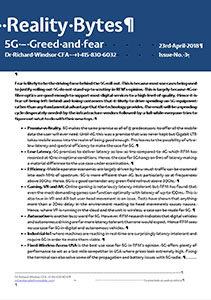RFM research subscribers will receive their copy directly by email.
Fear is likely to be the driving force behind the 5G roll-out. This is because most use cases being used to justify rolling out 5G do not stand up to scrutiny in RFM’s opinion. This is largely because 4G or fibre optics are good enough to support most digital services to a high level of quality. Hence it is fear of being left behind and losing customers that it likely to drive spending on 5G equipment rather than any fundamental advantage that the technology provides. The result will be a spending cycle desperately needed by the infrastructure vendors followed by a lull while everyone tries to figure out what to do with their new toys.
- Promise vs Reality. 5G makes the same promise as all of it predecessors: to offer all the mobile data the user will ever need. Until 4G, this was a promise that was never kept but Gigabit LTE takes mobile access into the realm of being good enough. This leaves to the possibility of ultra-low latency and spectral efficiency to make the case for 5G.
- Low Latency. 5G promises to deliver latency as low as 1ms compared to 4G which RFM has recorded at 10ms in optimal conditions. Hence, the case for 5G hangs on 9ms of latency making a material difference to the use case under examination.
- Efficiency. Mobile operator economics are largely driven by how much traffic can be crammed into each MHz of spectrum. 5G is more efficient than 4G, but particularly so at frequencies above 30Ghz. Hence, 5G is a good contender any green field roll-out above 30Ghz.
- Gaming, VR and AR. Online gaming is notoriously latency intolerant but RFM has found that even the most demanding games can function optimally with latency of up to 100ms. This is also true in VR and AR but user head movement is an issue. Tests have shown that anything more than a 20ms delay in the environment reacting to head movements causes nausea. Hence, where VR is running in the cloud and the unit is wireless, a case can be made for 5G.
- Automotive is another buzz word for 5G. However, RFM research indicates that digital vehicles and autonomous driving are far more latency tolerant than one would expect. Hence RFM sees no use case for 5G in digital and autonomous vehicles.
- Industrial IoT where machines are reacting in real-time are surprisingly latency intolerant and require 5G in order to make them viable.
- Fixed Wireless Access USA is the best use case for 5G in RFM’s opinion. 5G offers plenty of performance to act as a last mile competitor in USA where prices look extremely high. Fixing the terminal can also solve some of the propagation and battery issues with 5G radio.










Research Publication – ...
11 September 2023